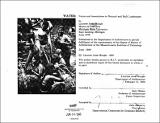| dc.contributor.advisor | Imre Halasz. | en_US |
| dc.contributor.author | Hungle, Laurene Anne | en_US |
| dc.contributor.other | Massachusetts Institute of Technology. Dept. of Architecture. | en_US |
| dc.date.accessioned | 2012-11-19T19:06:46Z | |
| dc.date.available | 2012-11-19T19:06:46Z | |
| dc.date.copyright | 1986 | en_US |
| dc.date.issued | 1986 | en_US |
| dc.identifier.uri | http://hdl.handle.net/1721.1/74780 | |
| dc.description | Thesis (M. Arch.)--Massachusetts Institute of Technology, Dept. of Architecture, 1986. | en_US |
| dc.description | MICROFICHE COPY AVAILABLE IN ARCHIVES AND ROTCH. | en_US |
| dc.description | Includes bibliographical references (p. 148-151). | en_US |
| dc.description.abstract | In nature, water appears as a drop, a trickle, a spring, a stream, a waterfall, a pool, a lake, a river or the sea. These myriad forms offer exciting visual and physical contrast within the natural landscape and evoke associations that nourish our creative and contemplative spirit. We need daily access to water; however, it is visually absent from most built landscapes. It flows in underground rivers. We are deprived of physical and emotional contact and the opportunity to experience it as part of an ongoing natural process. This thesis examines water in the natural landscape as a basis for incorporating water into the built landscape. Water offers tremendous potential as an emotional link between people and nature. It is also a critical segment of the hydrologic process. Water has the potential of becoming one of the many threads that weave the physical fabric of our environment. The methodology for generating this thesis involves the discussion of form qualities and associations as they apply to water in natural and built landscapes. Four sites are analyzed to exemplify effective and ineffective applications of water. These analyses discuss how water and the built landscape can be part of natural process and how water can enhance our understanding of place. On the basis of this inquiry, the relationship between natural process and the city is discussed. Reintegrating water into the city is life-enhancing; it offers the potential for clarifying our movement within the urban landscape; it acknowledges the complex interaction between human purpose and natural process. | en_US |
| dc.description.statementofresponsibility | by Laurene Anne Hungle. | en_US |
| dc.format.extent | 153 p. | en_US |
| dc.language.iso | eng | en_US |
| dc.publisher | Massachusetts Institute of Technology | en_US |
| dc.rights | M.I.T. theses are protected by
copyright. They may be viewed from this source for any purpose, but
reproduction or distribution in any format is prohibited without written
permission. See provided URL for inquiries about permission. | en_US |
| dc.rights.uri | http://dspace.mit.edu/handle/1721.1/7582 | en_US |
| dc.subject | Architecture. | en_US |
| dc.title | Water : forms and associations in natural and built landscapes | en_US |
| dc.title.alternative | Forms and associations in natural and built landscapes | en_US |
| dc.type | Thesis | en_US |
| dc.description.degree | M.Arch. | en_US |
| dc.contributor.department | Massachusetts Institute of Technology. Department of Architecture | |
| dc.identifier.oclc | 15464016 | en_US |
